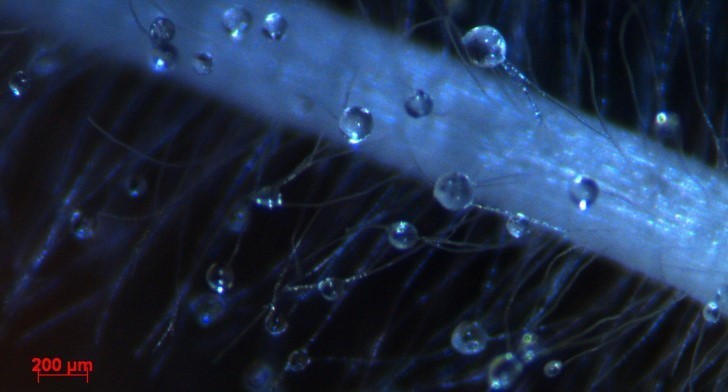
SP2: RhizoWater
Rhizosphere traits affecting water uptake
Summary:
Increasing evidence suggests that the rhizosphere hydraulic properties differ from those of the bulk soil. It has been shown that mucilage alters the drying and rewetting rate of the rhizosphere (Carminati et al., 2010) as well as the spatial configuration of water around the roots (Carminati et al., 2017a). However, the impact of rhizosphere properties on root water uptake and transpiration remains largely speculative (Ahmed et al., 2018a). Recently, it has been pointed out that root hairs allow for high transpiration rates and high leaf turgidity in drying soils and high evaporative demands (Carminati et al., 2017b). This result, besides proving the role of root hairs in water extraction, also shows that water potential gradients around the roots play a key role on plant-water relations. In other words, small (mm) scale processes around the roots are relevant for water relations at the holobiont scale. Hence, this subproject aims to understand the role of varying rhizosphere traits on root water uptake and transpiration, eventually.
Main research questions:
- How do rhizosphere traits impact root water uptake?
- What rhizosphere traits are relevant for root water uptake for varying environmental conditions (i.e. soil properties and climatic conditions)?
- Do old and modern varieties differ in rhizosphere traits relevant for water uptake?
- How to upscale from the rhizosphere (sub mm scale) to the root-system scale (dm to m scale)?
Objectives:
Within the framework the overall project, we aim to provide data on the variability of rhizosheath between old and modern varieties, and among modern commercial varieties grown in varying climates and to link rhizosheath mass to root hairs and mucilage production. In the following, the objective is to explain the mechanisms by which those rhizosphere traits impact soil-plant hydraulics. Therefore, we want to provide a mechanistic explanation of the effect of rhizosphere traits on soil-plant water relations and stomatal conductance at the plant scale. Ultimately, we focus on determining the impact of rhizosphere traits on transpiration (phenotyping platform) and yield (field sites). Consequently, rhizosphere traits will be included in a pragmatic hydraulic model that is capable of predicting the effect of soil drying on transpiration.
Methods:
We will use experimental as well as modelling approaches at the rhizosphere (sub-mm) and whole plant scale (dm). Imaging methods such as neutron radiography and Synchrotron-based μX-ray CT will be used to characterize the rhizosphere hydraulic and structural properties (i.e. soil moisture gradients around the roots and root-soil contact). High-throughput methods are currently being developed to quantify mucilage secretion rates, mucilage viscosity and root hair density based on the soil mass attached to roots (rhizosheath). At the plant scale, we will use an automated root pressure chamber that allows for simultaneous monitoring of transpiration, soil and leaf water potential. A numerical model will be developed to effectively include rhizosphere traits into a radial model of root water uptake which includes as parameters the root length density and the radius of rhizosheath. Our approach is to use an effective radial model of water flow toward the root surface, rather than an architecture model (such as R-SWMS, Javaux et al., 2008), which would require a large number of root hydraulic properties that cannot be easily measured. The radial model will be coupled with water flow into the plant tissues, including xylem cavitation, and across the stomata, similar to that of Sperry et al. (2016). The advantage of such a model is the pragmatic reduction of the hydraulic parameters needed for the simulations.
|
Contact |
||
|
Prof. Dr. Mohsen Zare |
Saniv Gupta (PhD candidate) |
|
Former colleagues (1st phase):
